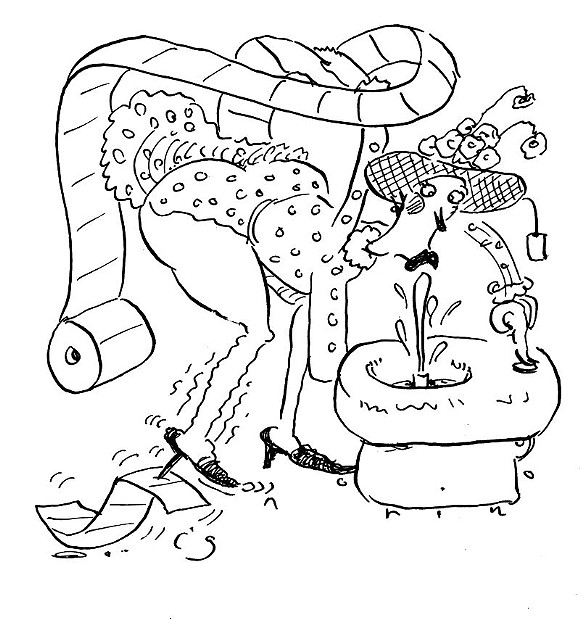I learned that in India people clean up differently after going to the bathroom—pouring water down their backsides with one hand while cleaning themselves with the other. Toilet paper, I’m told, doesn’t even factor into the equation. What I want to know is: Which is better for us and for the environment? Should we, as Americans, be switching? —Anonymous, for obvious reasons
HECK, they don’t just eschew toilet paper. Many in India eschew toilets altogether, with 67 percent of rural households reporting, in a 2011 survey, defecation en plein air. Part of the Indian style of relieving oneself stems from a lack of widespread indoor plumbing, sure, but the water method isn't just about not having toilets that can handle Western-style TP; using water rather than tissue to clean one's parts is common in plenty of places that have the economic wherewithal to afford sturdy sewage systems—Japan, for instance.
So your question’s a good one: What are they on to? And should we be taking cues?
The stakes aren’t low. As of 2009, Americans were using 36 million rolls of the stuff each year, something on the order of 15 million trees. Recycled material’s fine if you don’t mind a slightly scratchy experience, but popular ultrasoft varieties require tree fiber—some of it from old-growth forests. (Less than 2 percent of toilet tissue sold for in-home use in the U.S. is made from 100 percent recycled paper.) This isn’t the only way that TP is problematic, environmentally speaking. Scientific American reported that, trees aside, U.S. TP consumption requires, per annum, 473 billion gallons of water, 253,000 tons of chlorine (for bleaching; this can have harmful downstream effects on the immune and reproductive systems of wildlife), and 17.3 terawatts of energy. That’s some footprint.
The obvious alternative is the bidet—historically a stand-alone fixture, but increasingly available as an electronically-controlled add-on to an existing toilet bowl. Let’s assume that, given the environmental impact of TP, bidet use is probably better for the planet. But is it better for the body?
Alas, the scientific world is not flush with information regarding health and bidet usage. A 2011 paper out of South Korea reported that, at the correct setting, the electronic bidet could reduce anorectal pressure in people experiencing conditions such as fissures or hemorrhoids. But researchers seem keener to demonstrate its potential for improving the lives of elderly or disabled people, for whom wiping might be a challenge:
• A 2007 study found that an electronic bidet could be used by patients with spinal-cord injury to successfully induce bowel movement.
• In 1995 the Brunel Institute for Bioengineering introduced to the world the “Port-a-Bidet,” which people with disabilities could tote around to ease the experience of going to the bathroom away from home.
• A preliminary report in the journal Gerontologist suggests that “wash-and-dry” toilets may improve resident comfort and cleanliness in nursing homes.
• A Yale infectious-disease specialist has proposed that bidets may help prevent urinary tract infections in the elderly.
On the other hand, a 2010 study of subjects in Japan, where bidet usage is common, linked regular warm-water cleansing with the aggravation of vaginal microflora. And you’ll thank me for not describing the pictures published in a case study of an elderly patient’s perianal burns, caused by an excessively hot stream.
So, a mixed bag. We should note that in some places where water is involved, the prevailing toilet design is different from the American style—more of a hole that the user squats over. Here there’s a clearer benefit: the simple act of squatting, as opposed to sitting, requires less straining on the part of the defecator—an easier experience all around, plus it may reduce hemorrhoid risk. In a public-facilities setting, there’s also the obvious hygienic plus of not coming into contact with a seat that’s touched more asses than you’ll find at a Kenny Chesney concert.
Why haven’t Americans gone in for the bidet thus far? It might have to do with good old American exceptionalism. Like the hydrogen bomb and the Big Gulp, toilet paper is a proud U.S. invention, whereas it was the decadent French who brought us the bidet. (The word bidet, by the by, originally translated as “pony”—a reference to what one looks like astride the thing.) Things may be changing, but in both directions. On the one hand, there’s U.S. defecatory imperialism: we’re TPing the globe, as increasing usage in Brazil and China accounts for more of the toilet paper revenue picture overall.
On the other hand, last year the New York Times published not one but two articles about nascent American enthusiasm for a particularly high-tech line of Japanese bidet toilet seats, the Toto Washlet series, tricked out with heaters and dryers and pulsating sprayers. Toto (which recently opened a $60 million toilet museum back in Japan) has apparently dialed up its sales push in L.A., Chicago, Boston, and New York, hoping to finally establish a U.S. beachhead.
Who knows? It might end up finding a solid market here after all.


